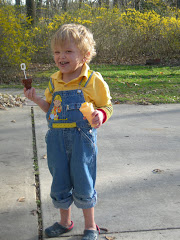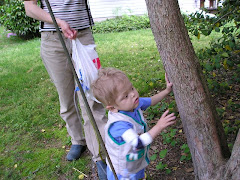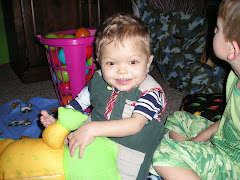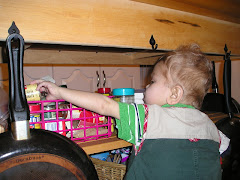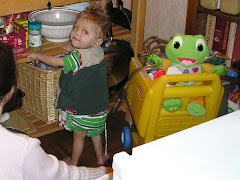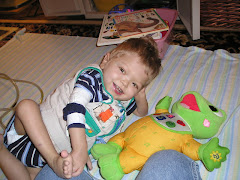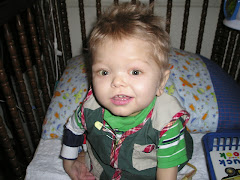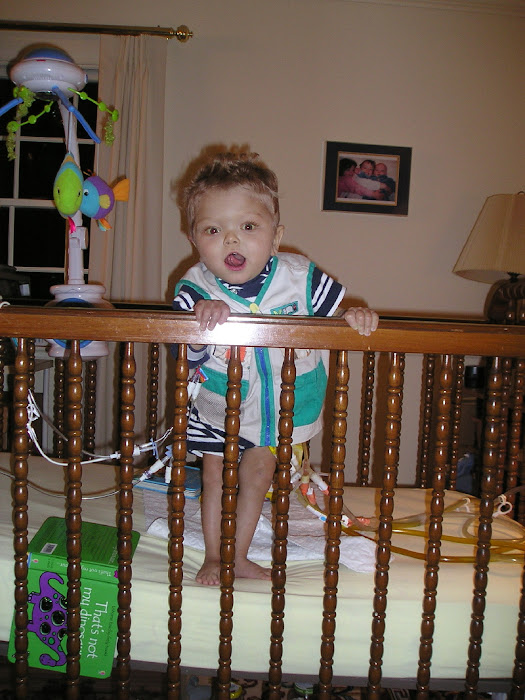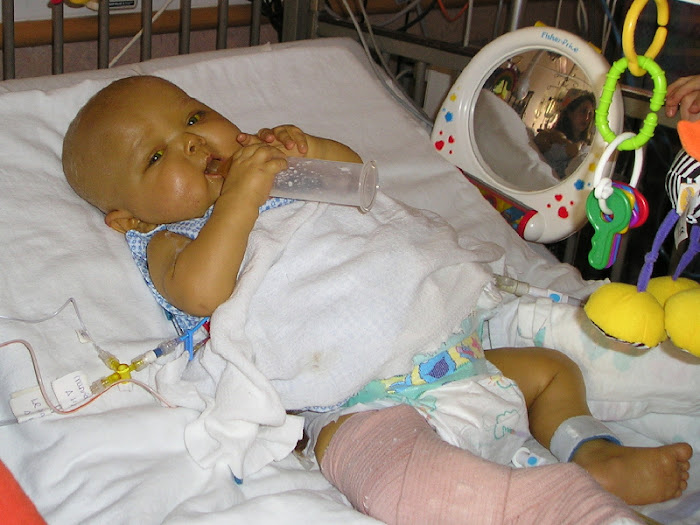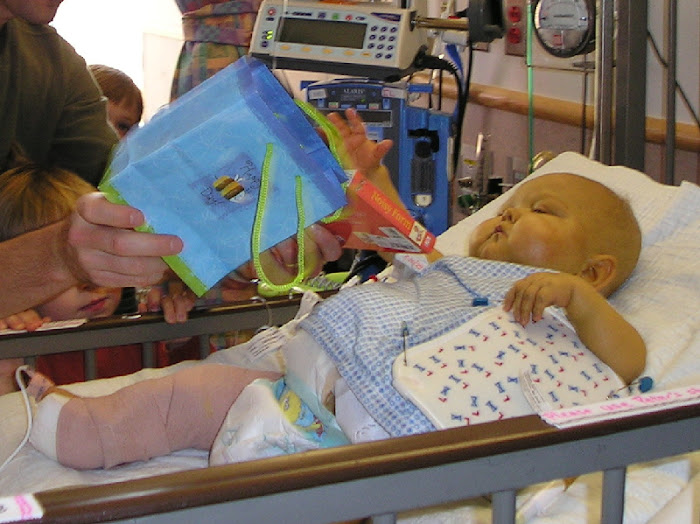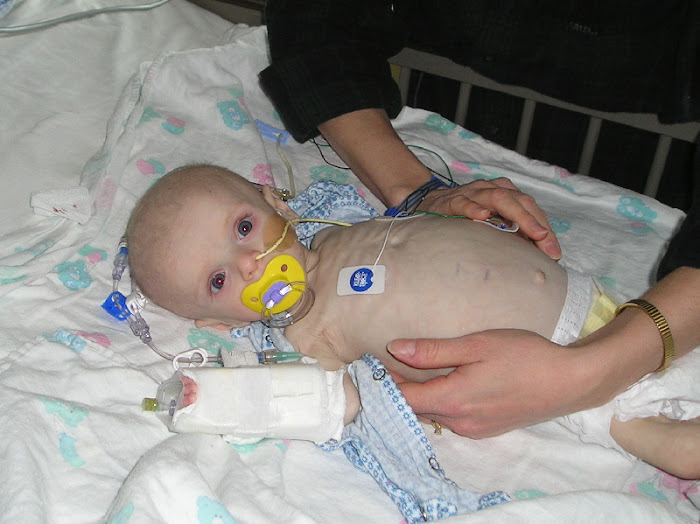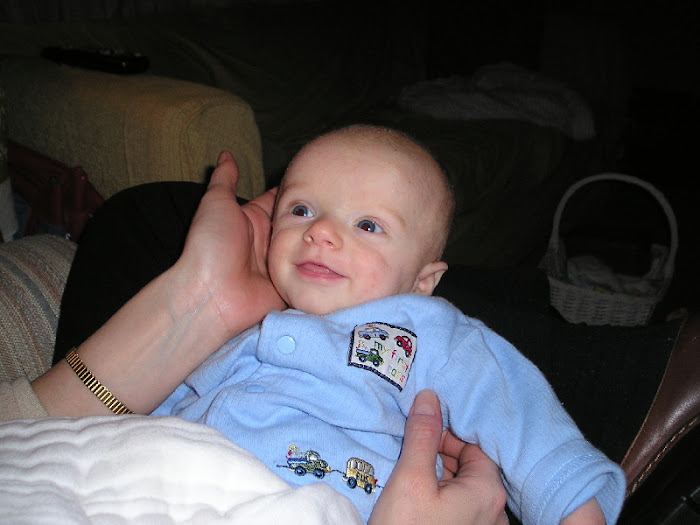Peter's CAIR appointment went well, but what we weren't counting on was an admission! Peter's blood sodium was at a value considered critically low, so he was admitted for correction of that low sodium. Apparently correcting hyponatremia (low blood sodium) too rapidly can lead to swelling of the brain, so there needs to be a gradual increase back to normal value, done in an ICU setting, at least until the level is high enough to require less labs and less monitoring.
Peter had been acting well, so the low sodium was a surprise to EVERYONE. The only real change in him has been a fairly high increase in fistula output over the past few weeks, continuing even after we changed to Elecare again (discussed in the last post). Peter dropped two and a half pounds over the last month, some of it is likely true weight loss since we had decreased formula concentration and amount without going up in TPN. More of the loss, though, seems to be the ascites that has disappeared over the last several weeks as the fistula output went up. The fistula output seems to have a high amount of sodium, and that has undoubtedly been the main cause of his low serum sodium.
There are a few reasons that the fistula could be putting out more, but to diagnose the cause with certainty would involve radiation to image the bowel. The prudent thing then is to do some trial and error with feeds and labs to monitor the sodium. If that doesn't work, then we will need to do further testing.
The trick is to prevent another bout of this hyponatremia. As such, the plan now is to go on TPN seven nights a week again, unfortunately. The reason for adding back all three nights off of TPN is because we have had to drastically cut back on feeds in an attempt to get the fistula to slow back down. He is getting just 10 mL an hour of formula now, whereas he had been up to 850 plus of formula a day. The hope is to slowly advance each week and to keep the fistula output from advancing with the formula increase.
The plan also is to keep the ascites off Peter's abdomen now that it is gone. He has had ascites even before the AVM was found. It is one of the symptoms that you often see with liver disease. With ascites, there is too much fluid in the body's abdominal tissue, and sodium affects that. For Peter, "too much sodium" is actually what would be a normal value for most people. When we see his belly get larger, we can tell without labs that his sodium levels are rising. It will be tricky to get his sodium leveled out without his ascites returning. It is so good to see his body without the giant abdomen that he has had for so long, and we all feel it is best for him to keep it from returning... if we can.
I have to say that if ever there was a "better" time for this to have happened, it was during this trip. We had already planned to spend the night in Boston, so we did not have to turn around and drive several hours back. As much as it is stressful going to the ER at 9:30 at night with a four year old who is hooked up to TPN and another IV pump that is the size of a double toaster, and an enteral feeding pump, along with an infant, it would have been so much worse had we needed to drive several hours back or needed to go to some other nearby ER that didn't know him at all. Dr. Kamin graciously called in to make sure that things went smoothly and that all parties involved were following the same plan for Peter. Even on vacation he called in to make sure all was going well. Thank you, Dr. Kamin!
Something of interest to add, is that during our ER trip, we encountered a Fellow who had taken care of Peter when she was a Resident at CHOP. She was just as surprised to see Peter as we were to see her. She remembers when he was at CHOP early on when the AVM had not yet been found, as well as when he was in the ICU at CHOP having bleeds requiring emergency transfusions. And she recalled that we left for Boston from CHOP's ICU to Boston's ICU so that we could get Peter on Omegaven. Now he is four years old, talking, eating, and one happy kid. We emphasized that Omegaven was the medication that helped him be able to get to this point, and that having one physician continually oversee him versus rotating doctors, also got him to this point. Hopefully she will remember these things as she goes on in medicine, and maybe they will be helpful to someone she cares for down the line.
One last thing.... Peter got his new PICC. It is a beauty as far as PICCs go, a little more bulky with the clamp, but it is a single lumen this time, so less bulk overall. Let's hope this one lasts a very long time. It works, so we are off to a better start than with the last PICC.
Monday, January 25, 2010
Saturday, January 9, 2010
Increased outputs and formula changes
We are back to Elecare from Vital Jr in effort to see if Peter is having some intolerance to Vital Jr. Peter's fistula and ileostomy outputs have drifted up over the last couple of months, and he has had 3 bouts of really high outputs with 2 needing him to go on Pedialyte for 2 or 4 days until it settled out. We were emptying his fistula bag every 1 to 2 hours at some points!
The other questions as to why his outputs have gone up so dramatically would be whether he is having bacterial overgrowth (SBBO)or if this is an anatomical change. We see that the fistula's output is consistently higher than the ileostomy over the last few months, but that did not occur anywhere near the timing of the gastrostomy repair which ended the stomach losses. Peter doesn't display his SBBO symptoms from the past though, so hard to say it is that. We did withhold his probiotics for two separate weeks in December, so it could be overgrowth. We are adding kefir and daily plain Stonyfield yogurt to his diet to assist with the usual probiotics in the event that he needs an extra boost of probiotic. Peter's history of reactions to enteral antibiotics for SBBO keeps us all hesitant to treat him empirically with a round or two of antibiotics. If anyone wants to know what he uses, we are still on VSL#3 and florastor, rotating one week on one and one week on the other, usually without a break between.
The good news seems to be that with the caloric decline that occurred by going back on 26 calorie Elecare from 30 calorie Vital Jr and by decreasing the volume from 950 to 650 per day, is that Peter is HUNGRY! He is remarkably interested in nibbling on crackers now, and as such is working on his feeding skills without prompting. And, although he has lost about two pounds with the diarrhea and with the reduction in calories, his new-found hunger may be showing us that his gut has been working well absorbing Vital Jr all along, despite the increased outputs.
Because he has lost weight, is showing us that he is hungry, and is continuing to slow down with his fistula output, we are going up in Elecare volume over the next few days. Hopefully he will regain the weight and keep the fistula output down. We will reassess where he is when back up in Boston.
The other questions as to why his outputs have gone up so dramatically would be whether he is having bacterial overgrowth (SBBO)or if this is an anatomical change. We see that the fistula's output is consistently higher than the ileostomy over the last few months, but that did not occur anywhere near the timing of the gastrostomy repair which ended the stomach losses. Peter doesn't display his SBBO symptoms from the past though, so hard to say it is that. We did withhold his probiotics for two separate weeks in December, so it could be overgrowth. We are adding kefir and daily plain Stonyfield yogurt to his diet to assist with the usual probiotics in the event that he needs an extra boost of probiotic. Peter's history of reactions to enteral antibiotics for SBBO keeps us all hesitant to treat him empirically with a round or two of antibiotics. If anyone wants to know what he uses, we are still on VSL#3 and florastor, rotating one week on one and one week on the other, usually without a break between.
The good news seems to be that with the caloric decline that occurred by going back on 26 calorie Elecare from 30 calorie Vital Jr and by decreasing the volume from 950 to 650 per day, is that Peter is HUNGRY! He is remarkably interested in nibbling on crackers now, and as such is working on his feeding skills without prompting. And, although he has lost about two pounds with the diarrhea and with the reduction in calories, his new-found hunger may be showing us that his gut has been working well absorbing Vital Jr all along, despite the increased outputs.
Because he has lost weight, is showing us that he is hungry, and is continuing to slow down with his fistula output, we are going up in Elecare volume over the next few days. Hopefully he will regain the weight and keep the fistula output down. We will reassess where he is when back up in Boston.
Monday, January 4, 2010
Peter's new PICC
The week before Christmas Peter needed to have his monthly labs drawn from his PICC line. Routine labs, routine procedure. Not this time. This time the PICC would not give more than 2mL of blood for labs and we needed about 20mL. So after some talks with the homecare nursing team and Children's Boston, we agreed that Peter's line could be tPA'd in the home setting now that he is bigger and no longer having active bleeding episodes that he had in the past. It was successful, got the blood needed for the labs, and then the line stopped flushing completely, and upon closer inspection, it had little particles floating in it. Everybody's guess is that the hard crystallized build up that we have seen in the line since last Feb, must have reacted with the tPA and started to flake off. Ugh! Since he has a dual lumen PICC, we decided to use the other lumen for his TPN and to get the line replaced. Monday the 21st of December we went to CHOP for a replacement PICC. It was just to be another rewire, which should be a reinsertion of a guidewire into the old PICC, removal of the old PICC, and then insertion of a new PICC over the guidewire. It should just take an hour once he goes into Interventional Radiology. We have had this done a few times now. Well, things started by a delay of three hours before even getting taken into the IR room, but no one telling us that the delay was that long. We kept being told we would be going there shortly. Three hours of keeping a wiggly four year old entertained is exhausting, and there was me AND one of Peter's nurses there! Then once he had been in IR for well over an hour and we still hadn't heard how things were going, I asked the nurse. She called IR and then they told her that the IR doc was in the process of placing the PICC line into the other arm because the rewire had been unsuccessful. When Peter was brought to the recovery room, we were told by the doctor that she had tried very hard to rewire, but the vein that the PICC had been in started spasming and was narrowed, so it was time to give that vein a rest. Poor Peter had to be given more sedation for that longer procedure though, so we ended up staying at CHOP until 8:30 that night and were the last to leave the IR recovery area. He was beside himself on the ride home - tired, and very thirsty. None of us even thought about his fluid replacement over the day other than a 300 mL bolus of normal saline during the procedure. Fortunately we had some Pedialyte to offer and were able to pick up more at WalMart on the way home.
Now for the real bombshell... the new PICC line has a LEAK!! At first I thought I was just being careless and getting Peter wet when flushing the line. Then I thought that perhaps the cap was faulty. Finally, we took a long hard look at it and unbelivingly, watched a drop of the flush solution drip out of the line as we flushed it. We flushed again, and there was another drip of solution. We took off the dressing and found that the dressing edges were wet from this leak, and the stat-lock was holding little droplets of fluid inside. The 'good news' is that only one of the two lumens has a leak, so once again we can give TPN until we can get a new line put in. Boston agreed to our request that they redo the PICC for us when we are up there again for Peter's intestinal rehab visit. Meanwhile, the red lumen with the leak is clamped off tightly, to be unused and unflushed until we replace it in a couple of weeks.
Now for the real bombshell... the new PICC line has a LEAK!! At first I thought I was just being careless and getting Peter wet when flushing the line. Then I thought that perhaps the cap was faulty. Finally, we took a long hard look at it and unbelivingly, watched a drop of the flush solution drip out of the line as we flushed it. We flushed again, and there was another drip of solution. We took off the dressing and found that the dressing edges were wet from this leak, and the stat-lock was holding little droplets of fluid inside. The 'good news' is that only one of the two lumens has a leak, so once again we can give TPN until we can get a new line put in. Boston agreed to our request that they redo the PICC for us when we are up there again for Peter's intestinal rehab visit. Meanwhile, the red lumen with the leak is clamped off tightly, to be unused and unflushed until we replace it in a couple of weeks.
Subscribe to:
Comments (Atom)

